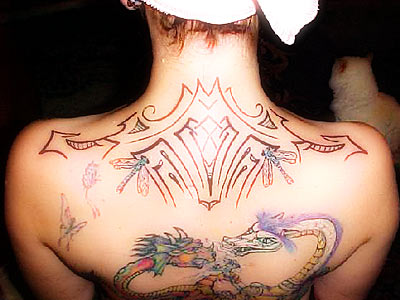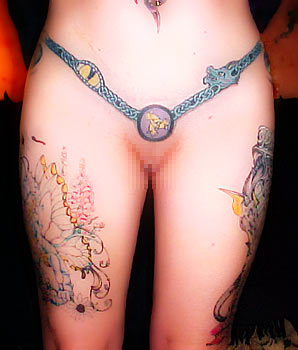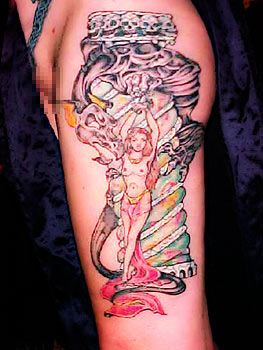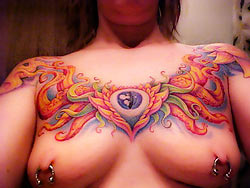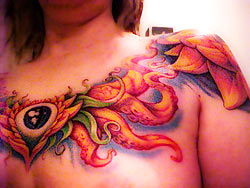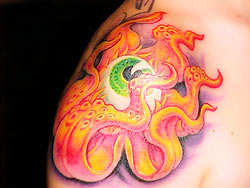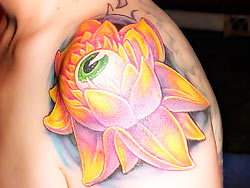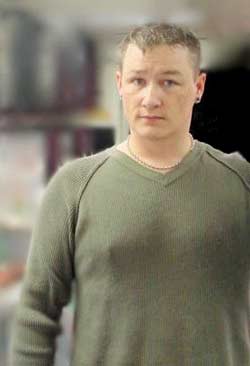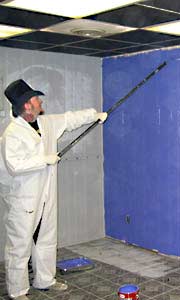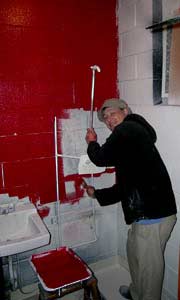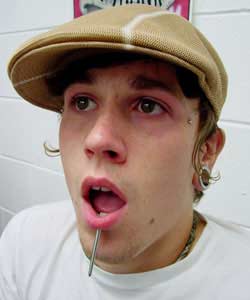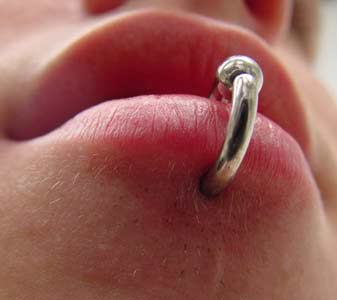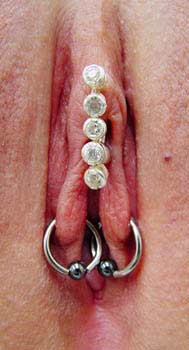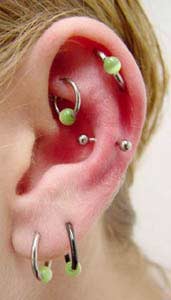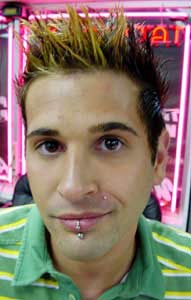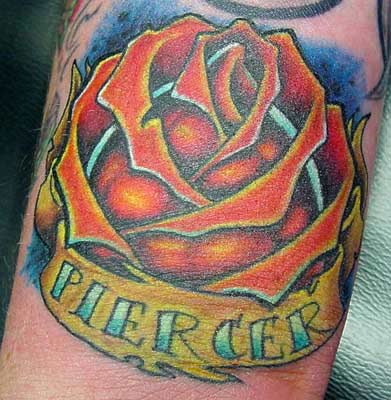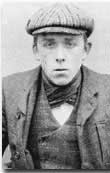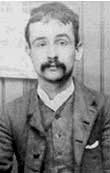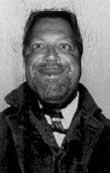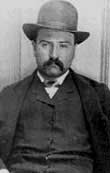
On August 20, 2005 I went to my first Suscon: the second annual All Grrls suspension convention. Outside of the article I’d written several months earlier about last year’s event and only ever seeing my first suspension eight weeks earlier, I didn’t know what to expect. Through conducting interviews with last year’s attendees and hearing entirely positive feedback, I knew the day would be special. The event was held in Toronto in a cozy, dimly-lit room with wooden floors and brick walls. The twenty-five attendees had travelled from all over the United States and Canada to be there. Rachel (IAM:tigertante) and Jill (IAM:feisty) were the organizers and wonderful hosts. They, along with the other staff, were competent, knowledgeable and organized. The absence of men felt somehow natural, but then again, I had nothing to compare it to. The girls who were nervous about being pierced or going up always had someone by their side; some supportive friends went the extra step and laid on the floor below the table while the hooks were being inserted, breathing deeply with them and holding their hands. Everyone was sensitive to the girls’ needs; allowing them to take their time if necessary, never pressuring them into staying up longer than they wanted to or coming down sooner than they were ready to. When the first article about the All Grrls Suscon was published, it sparked a lot of controversy. Some saw the event as discriminatory towards men, while others saw it as a proactive step towards getting more women involved in the suspension community. Regardless of people’s opinion about this event, no one can deny that it offers a safe and comfortable place for the experienced and inexperienced alike to hang. The thing that surprised me the most was the overwhelming emotion that hung heavy in the air. Excitement, nervousness, anxiety, intimidation, happiness, relief… although they were mixed feelings, they all felt warm. It was intense. It may be one of those things where you’d really have to be there in order to appreciate it… but then again, maybe not. To the tune of Svefn-G-Englar by Sigur Ros is a video of the the day— highlighting the emotions of the girl’s experiences— the thing that had the most impact on me.
2005 All-Grrls SusCon Video Report (9 minutes)
— Gillian Hyde (IAM:typealice) |
||||||||
|
Author Archives: BME
Post navigation
The Lizardman Q&A Part 10 [The Lizardman]

|
The Lizardman’s Questions & Answers has reached round number ten. For which I can, of course, only take half credit at best since I only supply the answers — the questions, as always, came from IAM members. The fact that no call for questions has gone without a steady response leads me to, hopefully, believe that these are still fun for everyone. They also helped form part of the basis for the The Lizardman FAQ I put online late last year.
Once again, thank you and enjoy:
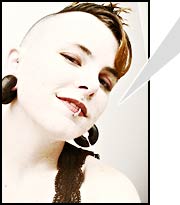 |
|
Have you ever thought of changing your diet to more resemble that of a lizard? |
|
I am a vegetarian, by taste, and I do eat live insects. So, depending on which one you choose my diet does resemble that of a lizard. Realistically though, the only things that I take into account when choosing my diet are taste and health (with a heavy emphasis on taste). I am a picky bastard as anyone who has ever gone to eat with me can attest. |
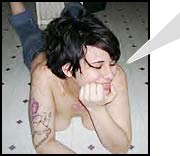
|
If tomorrow it became a federal law that tattoos are illegal and all of the tattooed people had to be rounded up and placed in camps across the nation, would you lead the march against the White House? |
|
Why are these hypothetical scenario questions so often gloomy and pessimistic? |
I would not march on the White House in such a situation — what you have described is well past the point of no return. I am nobody’s martyr! When I act and fight for modification rights and respect I do so out of enlightened self interest. What is good for all is often also good for me, but don’t think that I will blindly sacrifice myself or you will be very disappointed.

|
As we all know, you have traveled the world. I have not been able to do that. My question to you, since you aren’t the “norm”, what country or cities are more welcoming to your lifestyle? Are there certain countries or cities where the majority have frowned upon you if not shunned? |
The great thing about being an entertainer is that the world welcomes you. When I travel it is almost always for work — doing a show or an appearance.
I know that other people with public modifications on par with my own have had far different experiences in many of the same places. To answer your question though, I honestly can’t think of anywhere that particularly leaps out as welcoming or hostile to such a point based upon my modifications or lifestyle. My experiences most places are so focused that I kind of doubt I ever get a really good sense of what it is like on a regular basis — that’s part of the downside of touring. I get to go almost everywhere but I don’t really get to experience anywhere very deeply.

|
Where would your “optimal” place to live in for the rest of your life be? By that I mean somewhere you visited and really enjoyed and would like to, or you can imagine yourself living in for the rest of your life. |
|
The requirements for my happiness are almost completely unrelated to geography. The optimal place for me is one where I have my friends and family and the freedom to live more or less according to my own desires. I am very happy in Austin, TX currently and could easily see staying there. Besides which, I travel so much that I effectively get to live all over in a sense. |
|
What is your favorite species of lizard and reptile? |
|
I really like the various monitors and salt water crocs. |
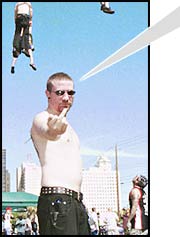
|
Why are you so lovable? |
|
Loving me is easy cause I’m beautiful. Heh. |
What kind of body modification makes you uncomfortable?
|
No particular kind of modification makes me uncomfortable — but it’s also not like I would watch subincision or flesh removal procedurals just for fun. If anything about a modification is going to bother me it will most likely be the motivation. When people get procedures as a means of one-upping someone else or seem to be pushed into it by others, that makes me uncomfortable. I also get ‘the willies’ when I see practioners doing things like cross-contaminating. |
|
Have you ever considered more subdermal implants (small flattish ones, on your arms, for example) to make your scales appear more “textured”? |
|
I’m not entirely sure how feasible such a massive implant project like that would even be, but it’s not something I would really want. In terms of texture for the scales I think that further tattooing will provide that adequately through the effect of color shading… I’m not currently considering any further implants with the possible exception of magnetic implants that would be essentially invisible. |
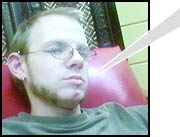
|
What’s your favorite movie, and favorite video game, and why? Or one of, seeing as ‘favorite’ is kind of tricky! |
|
It is very hard to pick a favorite. Besides which, my favorites have changed and likely will change again in the future. I can say that in terms of movies I have watched the original Highlander and Caddyshack more times than probably any other films. I still really like Highlander on a lot of levels but I am kind of burnt out on it, whereas I still watch Caddyshack at least once a week or more on the tour bus and Full Metal Jacket runs on a loop in our front lounge most days. For video games, I have a long running obsession with the Mortal Kombat series. |

|
Who’s your favorite comedian alive or dead? |
|
Rodney Dangerfield. I loved his stand-up style and his autobiography It’s Not Easy Bein’ Me: A Lifetime of No Respect but Plenty of Sex and Drugs not only inspired but also influenced me in terms of my own work. |
|
What book or books have you read that have had the most impact on you (or been the most enjoyable reads)? |
|
The Illuminatus Trilogy has profoundly affected me many times. I have read it at least once a year since I first found it in while in high school in the late eighties and I have no plans to stop. |
|
If you could sum up your philosophy of life in a sentence what would it be? |
|
I don’t know if I can do that yet. I definitely don’t think of myself as a role model but in terms of my philosophy, such as it may be, I do think that how I live my life is the best expression possible rather than trying to work language around it. If I have to take a swing at a one-sentence summary I’d currently go with: Survive and enjoy doing it. |
|
Do you feel like there are certain mods you’re missing out on that you couldn’t incorporate into your lizard theme? |
|
There are some designs and ideas I have had and passed on due to my overall theme but I don’t think I am missing out. Ultimately, if I really want something I find a way to make it work for me and my theme. I made the rules for this project and I will bend and break them as I see fit. |
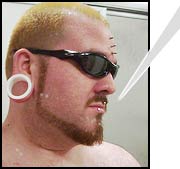
|
What’s your favorite city to perform at and why? |
|
I don’t have a favorite city for the simple reason that the city you are in is a guarantee of nothing. No matter where you are the crowd can be good or bad or indifferent (which is worst of all). Of course, there are general trends that I have talked about before but the closest thing I could say for a favorite is the town I am in any given night because that’s my focus. |
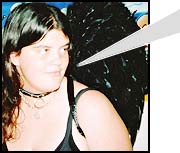
Who do you look up to?
|
I admire a lot of people but I try not to put anyone on a pedestal. The most important thing to remember about anyone you look up to is that they are still human and they have faults just like everyone else — this is especially important for anyone who might look up to me. A short list off the top of my head would be: Lanny & Cindy Sprague, The Great Omi, Rasmus Nielson, Robert Anton Wilson, Rodney Dangerfield, Penn & Teller, James Randi, Aye Jaye, Houdini, Andre Breton, Heraclitus, & Zeno. |
If you could meet anyone dead or alive who would it be?
|
I always hated this essay question in school. One of my favorite responses was to suggest that I wanted to meet myself under such conditions that I would have answer any question completely and honestly since we lie best to ourselves. I know that’s a cop-out so, I suppose I would like to meet the actual historical figure or figures behind the New Testament (I find the alleged evidence of a historical Jesus to be rather suspect) so that I could try and discern their motives and get a read on how they would feel about the abomination that their efforts have become in the many modern forms of Christianity. |

|
I know that at one point you were a doctoral candidate in philosophy — what was your planned dissertation going to focus on? |
|
It would have been a linguistic theory of art. My undergrad thesis was a treatment of the ancient problem of the one and the many using the latter Wittgensteinian notion of family resemblance. My doctoral thesis would have used family resemblance in a similar fashion to address the question ‘what is art?’. |
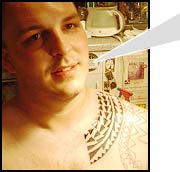
|
What special challenges do you face when travelling? Do you have additional issues getting through airport security, due to being “the green guy”? Alternatively, do you get special treatment in a positive light? Extra drinks from stewardesses, for example? |
|
My two main travel challenges are my show gear and other travelers. In terms of gear, you have to think about how airlines tend to view things like swords, traps, and flammable fuels (or their residue). Luckily, over the years I have gotten very good at streamlining my props and packing them for weight and security. Other people are a challenge because as much as I want to be polite and accessible, people who have layovers in airports don’t seem to understand very well that I may not have the same amount of time and that I need to get to my gate to make my flight. On occasion I do get a little special treatment. I fly enough that I have racked up elite status on some airlines and using the same ones means that in some places their staff tends to recognize and remember me. I have gotten quicker passage through security, upgrades, drinks, and been boarded earlier in the past. I have also been invited up to the cockpit a few times — including post 9/11. |
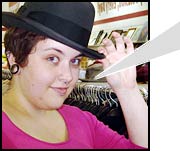
|
Your stage show does have a lot of sexual innuendo in it. Do women or men hit on you after shows? |
|
It does? Define “a lot”. I thought it was just right or a little low if anything. Anyway, yeah people do hit on me (both men and women) after shows, before shows, anytime really. As much as I am not a fan of wearing jewelry, the wedding ring is nice thing to have at those moments along with the phrase “I’m flattered but…” |
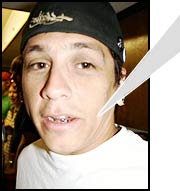
|
What is the one thing you collect that has nothing to do with sideshow memorablia or the “lifestyle”? |
|
I don’t really collect things. I have tried but I usually get bored or just forget. I have been keeping ‘do not disturb’ signs from hotels for a while but that is lifestyle related. I keep an archive of stuff related to my career and I gather circus, magic, and sideshow materials for research. If I wasn’t my own historian and researcher my possessions would probably be rather spartan or just clutter. |

Do you see yourself tattooing your body a second time around in the future to brighten your scales?
|
I think once will be enough, or at least I hope once will be enough. I won’t rule out touch ups here and there but I don’t envy the prospect of going over my whole body more than once. I’ll leave that sort of thing to Lucky Diamond Rich. |
|
I remember you mentioning a possible procedure to make it so that your navel is gone (only smooth skin, no proof that a navel ever existed). Is such a prodecure possible? Are you still considering it now that you have your stomach tattooed and colored? Ever thought of doing the same thing to your nipples or any other part of your body to add to your theme? |
|
The procedure is possible and was even recently shown on Modblog. I definitely still want to have it done, a touch-up to the tattooing in that area will likely be in order afterwards. My plan was and still is to also have my nipples surgically deconstructed as well. |
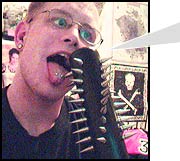
|
If there were a way to 100% safley and painlessly remove your ferrets’ fur and tattoo them would you do it? If so, what theme would you give their tattoos? |
|
I don’t see how this would be of any benefit to my ferrets or me; it really strikes me as rather absurd. I love my fuzzy little minions — and besides, they are already tattooed. My wife, Meghan, who is responsible for introducing me to keeping ferrets had the idea of getting similar dot tattoos but rejected it as not fitting with her urban legend theme. I am still considering getting one dot in the event that I get a vasectomy which is fairly likely (both the operation and the tattoo). |
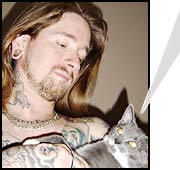
|
Were you always such a sexy beast? |
Without a doubt and only getting sexier. You may also have noticed my legendary humility.
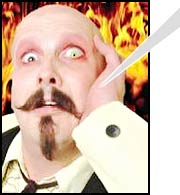
|
How many times have you been called The Enigma? |
How many times have I had to slap the taste out of your mouth? If anyone ever thinks I edit these questions (I don’t), just look at how often I take the ones from Orbax and Shawn Porter.
A lot, but he gets mistaken for me too — apparently all us tattooed folk look alike. In fact, I was once sitting next to him in Jackelope (a bar in Austin) and a person came up to talk to him (he was doing a show there that night) and they went on about seeing him on TV. Eventually they asked, ‘Can I see your forked tongue?’ He simply chuckled, pointed at me, and said ‘I think you want him.’
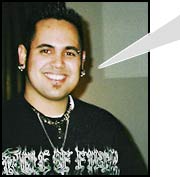
|
|
|
I love my bifurcated tongue, it is my favorite on pretty much every possible level. |
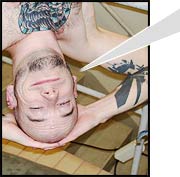
This is a two part question (hope you do not mind), how long is your tongue split? Did it or does it re-grow?
|
I don’t mind at all. The depth of the split depends on how I hold my tongue but is approximately a little more than an inch. It does not re-grow; the depth has been stable since it finished healing after the second operation in 1997. |
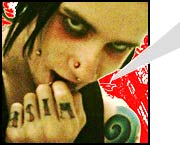
|
I have met you and you seemed a perfectly sane person, by my standards anyway. I was just wondering, why a lizard? Do you or have you ever felt a strong urge to be a lizard? Do you just like something about lizards, their reputation, their aesthetic qualities? How modded where you by the time you decided to under go a complete transformation? Was it always intended to be part of a show? If you did have some sort of urge to become a lizard, do you feel more complete now? If not, will you ever, or are you just a guy who always had an interest in mods and somehow decided to take it down the path of a lizard? |
|
It has never been about being a lizard for me, it is the transformation idea — I chose a reptilian theme based mainly on aesthetics. At the time I first started thinking about the project my only modification, to most people’s standards, was a pierced ear (done myself with a safety pin). By the time I truly committed to the project I had pierced and stretched my lobes somewhat and had begun some of the blackwork tattooing on my arms to see how well I would be able to take it. I did not originally intend it to be part of a show but that was a dream that has since come true. I wouldn’t say I feel more complete but it definitely has been and continues to be fulfilling. |
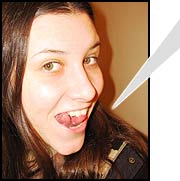
|
So how’d you choose a shade of green? |
|
I had limited options in terms of the greens available in tattoo inks, but I simply picked a bottle out the rack that looked good to me. |
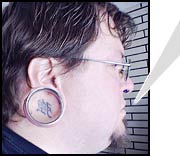
|
What event this last year was the most memorable to you and why? |
|
My Dad’s heart attack and recovery. The reason should be obvious. |
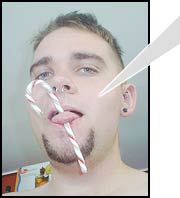
|
I’ve read a couple of times you would like a tail of sorts — ever thought about getting a subdermal implant near your tailbone and slowly stretching it (2nd generation 3rd gen, etc) |
|
I have had it suggested to me before but never seriously considered it. Even if that were a viable method for creating a tail, it would not effectively create the sort of long crocodile-like tail I would want. |
Also, when can we expect to see you in Australia?.. I want to see a Brisbane show, I’ll even shout you dinner if you head down this way.
|
I am still working on getting to Australia, I want to my show there as well — any promoters down there reading this? I’m ready to go. |
|
How did you train your snake to be comfortable and perform on stage? And by snake I mean your little green friend, not your happy green friend! |
|
Snakes are not particularly trainable (snake charmers and similar performers are often actually just choreographing their behavior around the snakes reflexive, instinctual reactions) but they do seem to ‘condition’ based on repetition. When I start working with a new snake I handle it a lot till it settles down and then I just go for it. The first few times through can be difficult but over time they seem to take to it as a matter of routine. Some recent experiments with snakes and mazes seem to indicate that they have more mental capacity than previously thought and perhaps this is similar to the ‘learning’ exhibited in those studies. |
 |
The Modern History of Tongue Splitting [The Lizardman]

|
“Eccentricity has always abounded when and where strength of character had abounded; and the amount of eccentricity in a society has generally been proportional to the amount of genius, mental vigour, and courage which it contained.”– John Stuart Mill
Eight years ago, in July 1997 (on the 18th to be exact), I walked into the office of Dr. Lawrence Busino with one tongue and emerged under an hour later with two. There was no media coverage and apart from a couple emails and a posting on rec.arts.bodyart not many people even knew this was happening. Of course, this would all change and an amazing and unforeseeable chain of events would be set into motion.
I was not the first person to have my tongue split, anyone who has paid attention to my comments about it will have noticed that I refer to myself as ‘one of the first’. My best guess is that I was probably the third bifurcation but the first to be done surgically using a biopsy laser. In fact, the first actual split tongue that I knew of was on BME just prior to my own procedure in 1997. An Italian man sent in notes and then pictures of his split created by cutting and silver nitrate cauterization. The notes can be found here, there are also six images early in the gallery with a June 1997 date stamp (for time received and posted, not taken).

The first known pictures of a modern tongue splitting (Italy, 1996/7)
When I first approached Dr. Busino I brought along printouts of those translated notes, by the time the pictures were online I had already scheduled my appointment for surgery. It was not until after my own procedure that I eventually found out about Dustin (covered in Body Play #16, I think) who had used a tie off method to split her tongue earlier. It seems that 1997 was the year for tongue splitting to happen. Within a very short span of time three people, unconnected and nearly unknown to one another, all split their tongues using three different methods.
Up until this time, modern tongue splitting was all but a myth. There were theories and vague references but no one could provide any documentation — it was always a friend of friend saw this guy/girl, etc. BME included a theoretical method reference for stretching multiple center tongue piercings and then cutting between them but this was just speculative. Some people made historical references but again the documentation was questionable. Even some of the more reliable sources citing a cutting the tongue in half do not specify a bifurcation and strong arguments could be made that they are talking about an amputation cutting in half as punishment or torture from side to side rather than from the tip back. The BME Tongue Splitting FAQ contains references to some of these historical practices. Personally, I find these less than compelling but I do not entirely dismiss the possibility since it only seems even more unlikely that someone had not tried it before. What can be said with good authority is that the idea and image of the split tongue is a powerful one that has played a major role across cultures and around the world. With the advent of modern tongue splitting, it was poised to do so again.
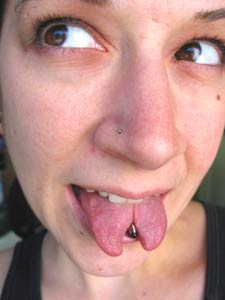
Dustin’s self-split tongue
Over the next two years tongue splitting would grow slowly but steadily. As word of my surgery and Dustin’s successful split began to spread (I have never heard anything further on the Italian), more and more people became interested or realized their own fantasies could now come true. I introduced a number of people to Dr. Busino as well as hosting many of them at my apartment in Albany (including our own Shannon Larratt who detailed his experience here) so they could come to town and get the surgery done by one of the only willing and experienced doctors in the country. Dr. Busino was very accepting, if not enthusiastic, about body modification and loved discussing various modifications and possible procedures. With each patient he continued to refine the procedure, especially the suturing which helped to prevent re-growth and provided a more natural rounded look to the interior of the split. At one point he even commented on how the laser machinery could be transported fairly easily to conventions or meetings where he would be able to potentially do many bifurcations were the demand to continue. Meanwhile other individuals and practitioners worked with the tie off method and experimented with scalpeling.
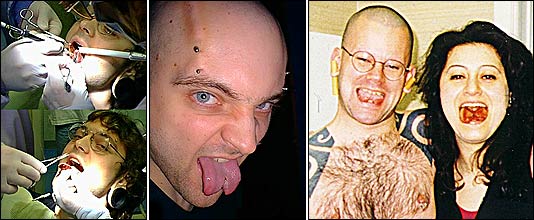
Early tongue splits on Shannon Larratt (left, center),
and Essie (right, one of the many people hosted by the Lizardman and introduced to Dr. Busino).
At the first Modcon in 1999 my split tongue was a novelty and, as I recall, the only one present other than Shannon’s. Between hosting many of the splits at my house and Shannon’s network of people and practitioners via BME we could say that at that time we probably knew personally or could at least name most of the split tongues in the world. This would soon change.
At the 2000 Modcon a number of split tongues were present. Online, BME was seeing a significant increase in photos and experiences. Due to my unabashed media whoring, my own tongues had appeared in Time magazine, on several television shows (such as Ripley’s), and even on a billboard in NYC. Split tongues were suddenly very visible. An increasing number of practitioners were offering the procedure and it became much easier for people to find someone near them to do it. Also, a number of people performed the procedure themselves. However, there would be a cost for this visibility.
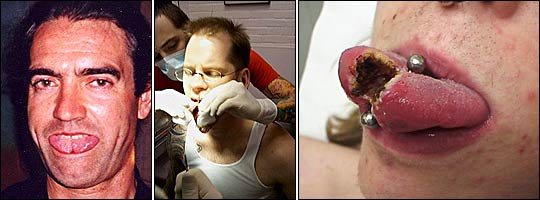
Early tongue splitting on Tim Cridland (The Torture King), Allen Falkner, and by Patrick Bartholomew.
Almost certainly due to the increased exposure and references to him in stories about tongue splitting, Dr. Busino found himself under unwanted scrutiny. As a result, of what I and others suspect was pressure brought on him by colleagues who found tongue splitting to be distasteful, Busino was soon refusing to do the procedure and even going so far as to deny having ever performed it. I last spoke with him 2000 before these problems arose. He was the model of an open minded professional when I knew him and it is a shame that the prejudices of others came to so bear on him. And, as bad as this was, the potential more even worse loomed ahead in the form of government legislation.
By 2001 split tongues were common as surgical modifications go, being one of, if not the, most popular ‘heavy’ modification. Keep in mind that’s not really common at all in terms of the world population or even just the US. In fact more people in the US get their ears pierced each day by underpaid, under trained employees in unhygienic mall stores often improperly using equipment and jewelry that even when used properly is at best barely adequate for the job than the entire collected world population of split tongues. Or to put it another way, if you had a dollar for every split tongue in the world you would not have enough money to buy a decent used car or pay the yearly rent on slum apartment in most cities for a year. Even though it sometimes seems like they are common within our modified community, they are still rare in the world.

More recently done tongue splittings.
Despite so many other prominent problems and looming dangers in the world, in 2003, some state legislators began to think that the tongue splitting “trend” required new laws. As a result, a number of laws have been passed which have limited the context in which the procedure may be performed. Most of these are redundant to existing laws and serve no real purpose beyond soothing the prejudiced positions of those who introduce the bills but they are preferable to the total bans they often start out as. This senseless waste of government time, effort, and money was the subject of my first official column for BME and can be found here. I continue to write and debate lawmakers across the country as they follow suit.
Due largely to these laws and the unwillingness of most doctors to perform the procedure a significant number of split tongues are now self done. The method of choice for them and the limited number of practitioners offering the procedure is scalpeling. Scalpeling the tongue is quite bloody, as many of the photos on BME will attest. However, it is at once the simplest and probably best method available. In my observations and from talking to subjects, it appears that scalpeling is on par with laser surgery for speed, if not faster, and results in far less swelling due to the lack of cauterization. When combined with proper suturing it results in some of the best looking, fastest healing splits with the least amount of re-growth between the forks. The only significant problem being that people doing it themselves or even having it done by most practitioners do not have the benefits at hand in case of problems or emergency that would be available in a professional surgical setting.
To date, the modern history of tongue splitting is an overall positive one. We have come to discover that it is not only possible but than many of the anticipated dangers or consequences such as difficulty speaking or eating are complete myths. Contrary to expectations the real problem seems to lay with reversing the procedure. This has happened once, to my knowledge, and was not voluntary or the result of any complication or dissatisfaction. No, the story of the only reversal is far darker and can be found on BME here. In fact, I do not, nor has anyone else I have spoken with know of anyone voluntarily reversing their split. It is this case that I think now points to the direction for the future.
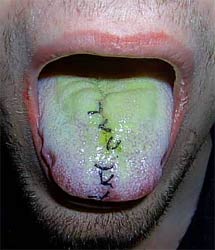
Forced tongue split reversal
The first tongue splittings were done for personal reasons of satisfaction and fulfillment. As a result others were able to do the same, likely for similar personal motivations. Now, as split tongues have become visible to the world it becomes time to establish their place within it. That is the work to be done. To cultivate the view and understanding that a split tongue is simply another way in which a person can — and should not be restricted from doing — shape their own image.

because the world NEEDS freaks…
Former doctoral candidate and philosophy degree holder Erik Sprague, the Lizardman (iam), is known around the world for his amazing transformation from man to lizard as well as his modern sideshow performance art. Need I say more?
Copyright © 2005 BMEzine.com LLC and Erik Sprague / The Lizardman. Requests to republish must be confirmed in writing. For bibliographical purposes this article was first published July 26th, 2005 by BMEzine.com LLC in La Paz, BCS, Mexico..
A visit to London and Remembering Mr. Sebastian [Running The Gauntlet – By Jim Ward]
 In March of 1978 the ITAA put on another tattoo convention, this time in Amsterdam. Doug and I decided we would attend. While vending was not an option, it was, nonetheless, and opportunity to meet people and proselytize for our favorite form of body art. Somehow our plans evolved into a month long vacation with Sailor Sid and Elizabeth Weinzirl joining us through most of it. 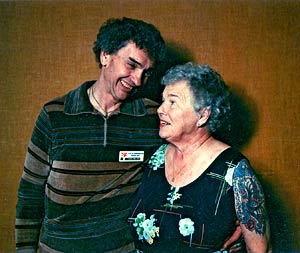 Doug Malloy and Elizabeth Weinzirl at the ITAA tattoo convention in Reno, 1977.
My lover Eric wasn’t included in the plans and wasn’t very happy about it. The fact was I didn’t have the financial resources to take him along, and he wasn’t bringing in any income of his own with which to pay his own way. By this time our relationship was already beginning to crumble. Elizabeth Weinzirl had a reputation as the grandmother of the tattoo community. At the time of this trip she was in her mid 70s though she could easily have passed for 60. She was a widow, her husband having been dead for a number of years.
She was a delightful, friendly woman, very much at ease in a wide variety of surroundings. Being around gay men didn’t phase her. Truth be told I think she was a bit of a fag hag. She seemed to bask in their presence, and on this trip she had ample opportunity. Elizabeth’s husband had been a health inspector. I probably wouldn’t even remember the fact except she told the story of his going to inspect a Chinese restaurant. When he pointed out a mass of garbage that needed to be disposed of, the chef replied indignantly, “Not garbage. Soup stock.” When asked why she got tattooed, she said that her husband wanted a tattooed wife. She considered the options and decided to get tattooed. Some feminists might find this offensive, but it was said tongue in cheek and with a twinkle in her eye. There was never any hint that she felt coerced, and my feeling was that she shared her husband’s interest in and enthusiasm for body art. She even confessed that she had had her nipples pierced at one time, but for some reason had taken the jewelry out. We arrived at Heathrow on Tuesday, March 7th for a week in London prior to moving on to the Continent. Our main reason for this lengthy stay was in order to spend some quality time with Alan Oversby, better know in piercing and tattoo circles as Mr. Sebastian. We also wanted to meet as many other British piercing enthusiasts as possible. Accommodating the four of us wasn’t possible in Alan’s small apartment — or flat as he would have called it — so he had made arrangements for us to stay with different friends. 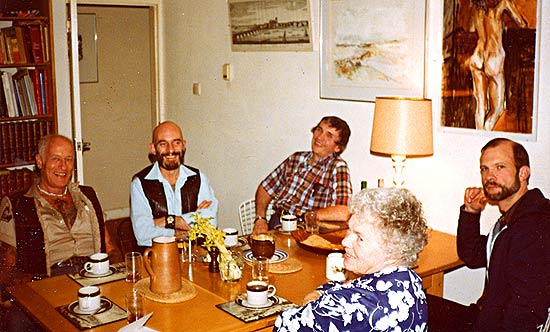 Around Alan’s dinner table, left to right, Sid, Alan, Doug, Elizabeth, and myself.
Regardless of where we stayed, we were all treated as honored guests. Doug and I stayed with a delightful gay couple who lived in Clapham. Their names were Mike and Robin. I believe Sid stayed with Alan, but I can’t remember where Elizabeth bedded down. It’s possible one of them stayed with a client of Alan’s named Rudy Inhelder. There are some pictures of Alan’s work on Rudy on a German web site. Not surprisingly Sid was his usual boisterous self, never missing an opportunity to joke around. While we were visiting with Alan, Sid happened to notice some folding chairs with clear plastic seats. It wasn’t long before he had instigated a photo op: getting a picture of his guiche and ass tattoo through the seat of the chair.
Elizabeth looks on. |
Pictures of the photo session remain, but unfortunately the snapshots themselves have disappeared.
Sadly, also missing are most of the photos that were taken at a cocktail party that was given in our honor. A dozen or more of Alan’s clients showed up. Elizabeth was the only woman present and was perfectly at ease as the clothes came off and the cameras began clicking. The few surviving photos I have are mostly closeups taken by myself or Sid or Alan.
 Alan’s flatmate Bjarne. |
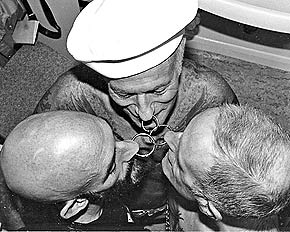 Alan, Sid, and a playmate of Alan’s he called Thing. |
My impression of Alan was of a rather private man who was a bit difficult to get to know. Not that he was particularly shy. He would casually disrobe and allow himself to be photographed, but there was always a reserved quality about his actions. He could converse with intelligence and ease, but to access the man behind the mask was a challenge.
During our stay in London I took advantage of the opportunity to interview Alan for PFIQ. Prior to becoming a tattooist Alan had worked as an art teacher. There’s no doubt his background as an artist was of great benefit when he left teaching to pursue his passions for tattooing and piercing.

Aside from any living canvases who may be alive still, I don’t know how much of his art work survives. One of my little treasures in a ceramic egg which Alan made as a gift for Doug. It is sculpted with male pecs and prominent pierced nipples and finished with a metallic glaze. Doug entrusted it to my care because he didn’t want it around the house where a family member might find it.

Ceramic egg made by Alan and presented by him to Doug.
When Alan was in his mid to late 20s working on a sugar plantation in British Guiana, he observed a couple of field hands who were wearing little gold earrings in their nipples. This was the beginning of his fascination with body piercing. He returned to London with his own nipples pierced. Within a few years he had acquired a number of tattoos and additional piercings as well. Over time many of them were stretched to accommodate sizable jewelry.
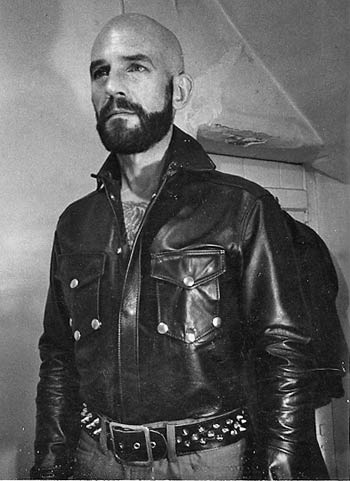
A younger Alan.
On one of the days we paid a visit to Alan’s tattoo and piercing studio in Wandsworth. He shared space with a leather business called Leather Unlimited owned by a man named Alan Selby.
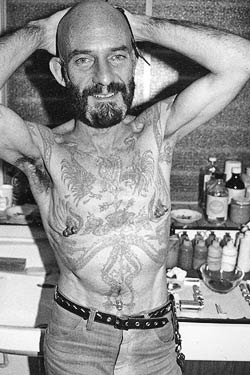 Alan in his studio at Leather Unlimited, one of the photos I took for his interview in PFIQ. |
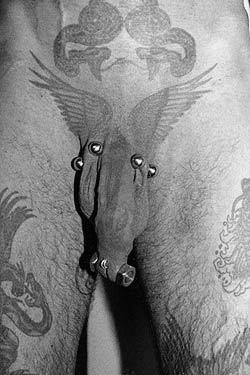 Alan’s genital piercings. |
Selby was one of the pioneers of fetish clothing for gay S/M enthusiasts. I recall that while I was living in Denver I had ordered a motorcycle cap from him. In 1979 he immigrated to the US and set up shop in San Francisco as Mr. S Leather. His warmth and easygoing manner endeared him to the local leather community. He worked tirelessly raising money and awareness for AIDS charities up until his death in 2004.
Mr. Sebastian’s space was meticulously clean and well organized. I would have expected no less. While we differed in our viewpoints on a number of issues, he and I shared a commitment to cleanliness and proper hygiene.
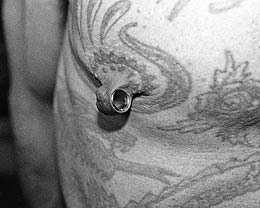
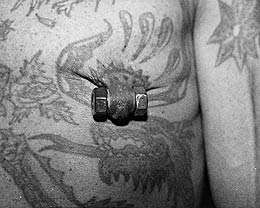
Alan’s stretched nipple piercings.
There has been much debate over the years on the subject of using anesthetics for tattoos and piercings. The early days of the piercing movement were no exception. Early on I experimented with topical anesthetics, but found that, with the exception of the Prince Albert and other piercings involving a mucous membrane, they were not very effective and hardly worth the effort. Especially in Gauntlet’s early days there was nothing available without a prescription that was of much use.
I strongly rejected the use of injectable anesthetics. From my perspective they were too risky to be used by anyone who wasn’t a physician or at least a nurse. This sense of danger arose from a couple of concerns. For one they can pose a health risk to some people. That’s bad enough, but a far more immediate concern was that in the US their use is illegal in the hands of an unlicensed individual. Assuming I could even have obtained them, I would have been putting my fledgling business at risk of being closed down and myself at risk of arrest for practicing medicine without a license. From my perspective it simply wasn’t worth taking a chance. I also felt, and still do, that when piercings are done by a skilled piercer, the pain isn’t significantly greater than the anesthetic injection would be.
As the years went by and I observed other piercers at work, I came to the conclusion that oftentimes they used anesthetics to mask their incompetence and lack of skill. It became my firm belief that the best thing a piercer could do to minimize discomfort and pain was to master the necessary skills and be able to perform a piercing quickly and accurately. This, in my opinion, eliminates the need for anesthetics of any kind.
Even though the legality of their use in Britain was not much different than in the US, Alan never seemed to be particularly concerned. He was able to obtain anesthetics through a physician friend and had no qualms about using them.
I must be honest; I had very little opportunity to watch Alan at work. Some years later I saw a video in which he performed a Prince Albert piercing, and I was a bit surprised by his technique. The piercing was done within the context of an S/M scene, and I’ve wondered if the crudeness was for effect and to deliberately prolong the discomfort. It took an inordinate amount of fumbling and time, and seemed to be more bloody than usual for this often bloody piercing. It left me wondering if Alan’s technique could have used some refinement and if it might explain his regular use of anesthetics.

Alan and a friend.
I don’t recall if this was the video that landed him in serious trouble, but in 1987 or 1989 — depending on which account you read — the Manchester police obtained a video of what they thought were people being tortured before being killed. In fact it was of a group of heavy S/M enthusiasts at a play party. Alan was one of 16 men charged in what became known as the Spanner case, and even though everything that transpired had been consensual, the court ruled that a person doesn’t have the legal right to consent to receiving what they considered bodily harm. Thus the convictions stood. Alan was jailed for 15 months, suspended for two years.

Eddie, a client of Alan’s and a co-defendant in the Spanner Case.
The case was appealed to the European Court of Human Rights, but Alan didn’t live long enough to hear the verdict. He died May 8, 1996. The final judgment in the Spanner case was handed down in February of 1997. In it the ECHR found that the British government had not violated the right to privacy by prosecuting the men involved.
More information on the Spanner case:
Spannerman (on BME)
http://en.wikipedia.org/wiki/Operation_Spanner
http://www.spannertrust.org/documents/spannerhistory.asp
http://vzone.virgin.net/old.whig/sadomaso.htm
http://www.modifiedmind.com/frontpage/extremebrit.html
Mr. Sebastian is considered by many — and justly so — as the father of the modern body piercing movement in Europe. Sad to say living on opposite sides of the world wasn’t conducive to our spending much time together. The Internet was still in its infancy, and with the pressures of our businesses and lives, we weren’t very good correspondents, so communication between us was minimal. Still, I am happy to have known him personally and to have shared the spotlight with him.
Jim Ward
http://www.gauntletenterprises.com/
| Jim Ward is is one of the cofounders of body piercing as a public phenomena in his role both as owner of the original piercing studio Gauntlet and the original body modification magazine PFIQ, both long before BME staff had even entered highschool. He currently works as a designer in Calfornia where he lives with his partner.
Copyright © 2005 BMEzine.com LLC. Requests to publish full, edited, or shortened versions must be confirmed in writing. For bibliographical purposes this article was first published July 15th, 2005 by BMEzine.com LLC in Amsterdam, The Netherlands
|
 |
No Boys Allowed! Introducing the All-Grrls Suscon [Guest Column – Stepping Back]

There is something special about a group of women. There’s a particular vibe, an energy. Together, women are gentle, honest, open and sensitive. We easily comfort each other, we’re attentive and supportive. Topics of conversation, body language, our voices are different, and the presence of even one man can change everything. There is a connection that goes beyond our anatomy, beyond any common interests or friendships. Women don’t even have to like one another in order to feel the bond. We are different than men. No better, no worse, just different. With this knowledge and their love of suspension, Jill (IAM:feisty) and Rachel (IAM:tigertante) created and hosted the first All-Grrls Suscon last year, and it was a success. It was so successful, in fact, that they’re at it again! This year’s event will be held in August in Toronto. Suspensions cost $100 and pulls cost $50, and any woman, experienced or not, is welcome to come. The exact location is still to-be-announced, so keep your eye on the All-Grrls Suscon event page. To reiterate: there are NO BOYS ALLOWED! As smoothly as last year’s event went, the idea of a women-only Suscon did stir up some controversy. There were a few members of the suspension community who felt it was unfair to exclude men. Jill and Rachel want to emphasize that this is not anti-men, but rather pro-women. They had been frustrated by the way they’d been treated by men at other events when they first entered into the community, and wanted to show themselves and others that women are just as capable as organizing, setting up, and suspending as their counterparts. They surpassed their goal, proving to everyone that an All-Grrl’s Suscon wasn’t just a great idea, it was great in practice too.
|
||||||||||||||||||||||||||||||||||||||||||||||||||||||||||||||||||||||||||||||||||||||||||||||||||||||||||||||||||||||||||||||||||
| BME: | What has your feedback been from men about this event? |
| JILL: | The feedback was great. I think there were a bunch of men that couldn’t believe that we actually did this. We sure showed them! The men in both Rachel’s and my life are very supportive and they respect us for what we do. They know we are highly skilled in suspension and rigging collectively and put on a great, successful event. We definitely had a bunch of grief from men out there that don’t think there are enough trained wimmin out there to work the suscon. |
|
*** I had to talk to the men who disagreed with the idea, and I found two who were willing to speak out. Cere (IAM:Cere), a member of the ROP (but whose opinions don’t represent anyone’s but his own) admits that his point of view is very unpopular, but he does not like the idea of the All-Grrl’s Suscon. Rachel, Jill and Cere are all very good friends, but his opinion differs dramatically from theirs. |
|
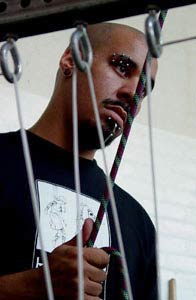 IAM:Cere
Cere: Simply put, I am completely against the idea of it. I understand the idea that a woman might be more comfortable around other woman suspending and the idea that at a large event that might have a woman suspending topless or nude may bring gawkers from the male gender. I call bullshit on it. You are just as likely to have a bisexual or lesbian woman admire a naked girl as you would a guy. Also at every single event that we have thrown there has been nudity or toplessness and we have never had a problem with someone being rude or leering. If you are uncomfortable with your body, set up something private. The main reason is though is the hypocrisy behind it. If I were to throw an All-White suscon or a No-Minority suscon, everyone would be up in arms screaming about it. But it’s okay that an entire gender is being discriminated against in a community that is supposed to celebrate the oneness of humanity? Fuck that. That said though, I love Rachel and Jill, and they are awesome friends of mine. I hope their next event goes off without a hitch and I hope that everyone who hangs there has an amazing experience and gets the most out of their suspension. |
|
|
||
Code Zero: I personally didn’t feel like any one-gender event is fair or just. I understand that these women feel more comfortable without any guys there, but I’m a larger guy and I don’t necessarily feel comfortable with a ton of strangers around, but if I had a “Fat guy only” event, it would get protested by women and men alike. The whole BME/IAM scene is about acceptance and togetherness, and this event felt like a slap in the face. Having an invite-only event is one thing because it prevents having people come just to gawk, like the highly secretive MODCON, but to exclude someone based on nothing other than gender, it’s not right. It’s sexist.
Do you think it would be okay for someone to organize a “Blacks Only” Suscon if they felt that black people would be more comfortable doing suspensions without anyone else around? It may not sound like the same thing, but at its core, it’s exactly the same thing.
|
|
|
| BME: | What would you like to say to people who view this as an “anti-men” event, instead of how you intended it: a “pro-women” event? |
| JILL: | I know some people don’t understand why men can’t be there, but this is all about being pro-wimmin. There is an emotional and physical difference between men and wimmin, and if you can’t get that, you have bigger problems than just not being allowed in to our event. I have spoken to many men who will outright laugh at other men who don’t understand the difference between men and wimmin. Many men know that this is an important and necessary event. I had men tell me last year that the only difference between men and wimmin was our genitals. Pardon me as I stop laughing. A few guys retaliated with comments like, “Well, what if there was an all male suscon?” I think, up until a few years ago, the events were an all-male Suscon. Wimmin are just starting to become more prominent in the suspension community. The All-Grrl Suscon is an event where wimmin can feel free to be themselves and not worry about what the men think. |
| RACHEL: | To them it’s all about us hating men, which is strange considering that these comments come from men we know and love and who know and love us. As much as some of us hate to admit it, our society is still deeply infected with patriarchy, sexism and misogyny. What Cere fails to notice is that every day is white, heterosexual male day. My god, wimmin weren’t even able to vote until 1920, whereas Blacks had the right fifty years prior. I think that speaks miles about North America’s views on wimmin in society. Not to mention wimmin still face a substantial economic inequality. I think that although gender equality is definitely ideal, we’re still working on it, and there is still a need for wimmin to create empowering spaces for themselves. I think it’s difficult for a lot of men to understand that.
Cere suggested that we create a private event, and that’s exactly what we’ve done! I too, have never seen blatant gawking at a suspension convention, however I think one would be hard pressed to find a man who does not consider nudity in wimmin to be a highly sexually charged thing. I think it is difficult for men to look at wimmin’s bodies and not regard them in a sexual context. A breast is never just regarded as any other non-sexed part of the body such as an arm or a leg. I disagree that wimmin who are sexually attracted to other wimmin lack the same discretion. I feel that a wimmin’s only space allows grrls to reveal their bodies in a non-sexual manner. The majority of the feedback we’ve heard from men has been positive and supportive, which is really great. Of course a few people have their knickers in a knot over the concept of a wimmin-only event and there has been a little backlash, but from what I’ve heard the feedback is primarily positive. |
|
*** As Jill said, there are men who completely agree with the ideals behind the All-Grrls Suscon.
|
|
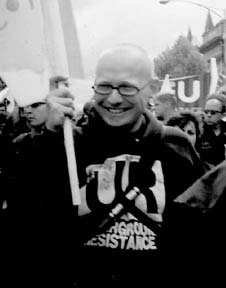 Graham Wilson (IAM:[tan])
|
|
[tan]: Without a doubt, I believe it’s important to have an All-Grrls Suscon. Men dominate the suspension and the modification community in general. Any chance for a minority in a community to get together and share ideas, knowledge and experience can only enhance equality. It may be difficult for some women to be half undressed in front of men (who may or may not care), which can add another mental hurdle that would encourage them to turn away from suspension. Suspension is difficult enough as it is and for first time suspenders feeling self-conscious it is not going to help at all.
Frankly, there are currently very few women staffers. Men throw the hooks, men hang from hooks, and men hold the knowledge. Suspension has become a male dominated experience and if you dispute this, have a look at the suspension galleries and experiences on BME. There is a lack of a female voice and knowledge.
Let’s ask women what they want. If women want to suspend with other women, brilliant, let them go ahead and do it without feeling like they are harming the suspension/modification community. The more people that feel free, comfortable and safe to suspend, the better!
|
|
|
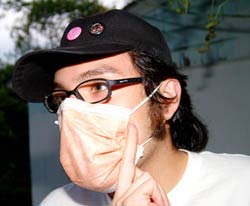 George (IAM:Useless) is a member
of the NY ROP chapter. |
Useless: In a way, I think it is good to have an All-Grrls Suscon. There definitely aren’t enough women in the suspension community, so this is a good opportunity for people who want to learn. I’m a bit concerned about the staff, because there are only a few female suspension artists that I trust. I understand how this event is a pro-women but to some extent I do understand how the men (boys?) can see this as an anti-men event. It’s a bit of a tricky situation, but if this can help some females learn more about suspensions, then I’m all for it.
Of all the BBQs, shows and Suscons I’ve been to, I don’t think the female suspension artists have been treated any differently. I have worked side by side with females and felt just as comfortable with working with them as I do a male. I know that people aren’t randomly chosen like a lottery to join these suspension teams; it’s a lot about trust. To the few females that will be working this event, I know they will use their skills and best judgment to make this event a memorable one. Just like the entire suspension community does for every event.
|
|
|
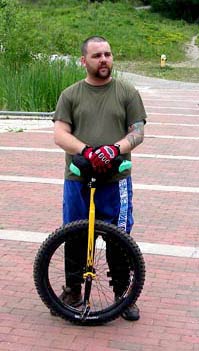 IAM:PhilipBarbosa
|
PhilipBarbosa: It’s about time this happened! The suspension community needs to have more well trained practitioners and a much stronger female presence. It’s an asset to what we do! I agree, for too long much of the community has been male dominated, but as time has gone on there has been a growing population of really amazing wimmin with drive, dedication and tough fucking skin! It’s really nice to see, and I’m proud and really just very happy that there is such a positive response to this project.
Occasionally, I tire of being involved in this community, mostly when I encounter apathy, but its events like this one that really make me think about how powerful an experience like this really is and what amazing things we can all do.
That said, I also believe that tigertante is one of the most skilled and best trained suspension practitioners I have ever had the pleasure of working with and I trust her with my life. Following through with her commitment to make an event will certainly do amazing things, not only for the suspension community but for your selves as well. We need new blood to pump into what we are all trying to establish. A stronger female presence is exactly what the community needs right now!
|
|
|
| BME: | What if someone has a boyfriend that they really want to go with them, can he come? |
| RACHEL: | Nope, no exceptions. |
| JILL: | I think that there are tons of people out there who want their partner to be present when they suspend. Unfortunately, the All-Grrl Suscon is exactly that. All wimmin. There are many other Suscons where everyone can go, and all we’re trying to do with this one is offer something a bit different. If it doesn’t fit into what your ideal experience is, then maybe it isn’t’ the event for you. We know it’s not for everyone. But those who came last year enjoyed it. |
| BME: | Rachel, last year you said “I’m sick and tired of sausage-fest Suscons and would love to help create a safe, friendly space for wimmin out there who want to suspend but are possibly uncomfortable at boy-dominated events to step out and experience a pull or suspension themselves!” Do you still feel as though Suscons are “sausage-fests”? Jill: Do you share her opinion on this? |
| RACHEL: | I think that comment stems from the my experience at the Dallas Suscon, but in the past several years, since working with both ROP and IHUNG crews, the environment has changed into one that’s much friendlier toward wimmin. Thanks to them, I no longer consider Suscons “sausage-fests.” |
| JILL: | Suscons are, or at least have been, sausage fests. It is a very male dominated community. First off, there aren’t as many wimmin out there that are interested, and wimmin tend to be a bit more timid than men when getting involved in something like suspension. The men that we know are extremely talented at what they do, but not everyone tends to be totally accepting of wimmin in “their” space. Now that there’s an All-Grrls Suscon and more wimmin attending mixed-gender events, I do see a positive change in the community. |
| BME: | What are you doing differently at this year’s All-Grrl Suscon in comparison to last year’s? |
| JILL: | We’re going to make small improvements so that more wimmin can go up and stay up longer if they want to, so we’re hopefully going to have more than two stations and more staff. We haven’t decided on a particular spot to host it, but we know it’s going to be bigger. I’m really excited about the great atmosphere it will be. Last year people only wanted to do suicide suspensions, so we’d really like to see different styles at this year’s because I think it’s good to see people try a variety of different things. |
| BME: | Why was that the only kind done last year? |
| RACHEL: | I think the fact that it was a lot of these grrls’ first time had a lot to do with the domination of the suicide suspension. The suicide position is definitely the most common style attempted. I believe most people think it’s the “easiest” method because there are a minimal number of hooks and the suspendee can’t see them, which make a lot of people feel more at ease, even though fewer hooks means more weight on each hook. It’s also a relatively comfortable vertical position so people can feel free to spin and swing around. |
| BME: | What were you most surprised about with last year’s event? |
| JILL: | How smoothly it went. |
| RACHEL: | I was probably most surprised with the incredible atmosphere that we created during the event. It was so amazing to be working with an all-grrl team. It ended up being a really heartwarming, positive experience. |
| BME: | Did you hear back from any of the girls after they left the event? What was the general feeling about the event? |
| JILL: | I know people can’t wait till this year’s event. |
| RACHEL: | I heard back from a number of grrls saying how much they enjoyed the experience and thanking us for putting it on. I think I heard from way more grrls saying how much they hated to miss it and to tell them when the next one is coming around! But in general, everyone was incredibly positive about how the event ran. |
|
*** They’re right, the feedback from the women who attended was extremely positive. I spoke to a few of them about their experiences.
|
|
|
|
|
I found the atmosphere really calm, friendly and very relaxed. There was no rudeness, attitudes or egos and no one was showing off. The experienced people were really open with their feelings and knowledge about suspending and pulling which was important because the majority of the participants were new to it, and I was new to working at a Suscon. I was comfortable talking about my experiences suspending to anyone who was interested, which surprised me considering I had just met a lot of the people there, but was willing to share a lot that I thought I would never be able to tell anyone.
There was no specific schedule to adhere to because many of the participants had never suspended or pulled before and the staff did not want to push people to go up, but rather to let them go at their own pace. The comfort level was definitely raised because there was no one who might make an ill-timed or inappropriate comment on purpose or by accident. No one seemed self-conscious at all about their clothing choices and they generally seemed very happy at the idea of “girl power” and just being at such a special event.
|
|
||
Badcat: I arrived with a friend of mine, only knowing Rachel and no one else. I initially wanted to try a pull, but by the time it was my turn, I’d changed my mind and wanted to do a suspension instead. It was a very comfortable atmosphere with really friendly and positive attendees, and there wasn’t a competitive aura. I felt a lot of support and acceptance about the girls’ preferences about doing pulls compared to a suspension, and how they were to be done (number of hooks, etc). I was impressed with how safe and health-conscious everything was arranged. They had food, juice and water for people to prepare their bodies with and there was even a hammock to recoup in!
The rig was set up in a private backyard with grass below your dangling feet, the fresh perfume from the flower gardens teasing your senses, and the warm sun on your skin. I couldn’t have felt more secure with my surroundings and it was one of the most spiritual experiences I’ve had. I was dealing with a rough relationship and had been very stressed in the month leading up to the suspension. Once I did mine, I felt crystal clear and very cleansed. I’ve never experienced anything like that before with such intensity. I can’t wait to do it again at this year’s event! |
||
|
|
||
|
||
Alyssa Jane: That day I decided to do my first pull. The atmosphere was a lot different than any other event I have ever attended. There was a general feeling of support in the air even though I had never met any of the other attendees; they made me feel as though I had known them for years and it really put my mind at ease. There were no gawky onlookers, no pressure to act tough or to perform. It’s wasn’t necessarily more “comfortable,” but I did notice a completely different atmosphere than at other events and because of it, I felt very calm. One thing that sticks out is that it was the most organized event I’ve ever seen. If I didn’t live so far away, I’d be at this year’s, for sure!
 IAM:vampy
|
vampy: I had travelled from England and didn’t know anyone at the event, but I immediately felt welcomed. It was a very relaxed atmosphere and all the girls were walking around talking to each other. I’m not the sort of girl who tends to seek out, or feel more comfortable in the company of women. I do have female friends, but the majority of my friends tend to be male. I felt relaxed and had fun chatting to people, just as I did the next day at BMEfest where there were men around. I didn’t suspend because I need to know someone very well before I can feel comfortable enough for them to suspend me, but if I had, I think the all girls rule would have been more of a hindrance than a help. While I would have been happy suspending in front of all of the people there, I like to have my close friends around when I am suspending, and most of them are male.
In the piercing tent, the atmosphere was very different than what I was used to. Previously, I had only worked alone or alongside men while piercing for suspensions. The atmosphere was a lot more open and relaxed. In my experience, I have felt that when offering a different opinion to male piercers (something like “don’t you think she’d be more comfortable if we lower the marks half an inch?”) they instantly see this as criticism and get defensive. I felt a lot more like everyone was working together for the benefit of the suspendee, and there was much less ego involved. At one point one of the organizers came over and asked me if there was anything we did differently to them and why; I’ve never felt that my opinion was respected as much at an event with male piercers, even by those with less experience than me.
After returning home, I did a small suspension event with another female piercer and mostly girls helping out (though there were a few men around). I found exactly the same thing while working; that we seemed to get along better as a team, and there was continual communication about what had been done and what needed to be done. Having said that, I did another event shortly after where I got to work alongside a wonderful male piercer. I found exactly the same thing working with him, so it’s not exclusively women I enjoy working with, but I do think that in general women accept constructive criticism as it is meant, and pay more attention to the needs of the suspendee.
|
|
||
|
||
Dyzcordia: This was my first suspension event and I did a chest pull. I wanted to go because it seemed as though it would be a smaller event than a lot of the others, so I thought I’d feel more comfortable. It was in Toronto, where I live, and it came at a time when I was craving the influence of female energy. I think there is something very different about being in a group of just girls, and it’s as much about how women are different with each other when there are no men around as it is about not having to interact with men.
There was an aura of excitement, that kind of eager anticipation that can be almost tangible. I felt that it was very well organized, but not overly so either. There was no sense of disorganization, but rather a lot of room for flexibility. It didn’t seem like there was any set order that people were suspending in, each person just seemed to go when they were ready. Everything seemed to just flow well. I am planning to go to this year’s event and am pretty excited about it.
I know that there was a lot of controversy surrounding the issue of whether or not excluding men was a negative action, but I don’t feel that the point was to exclude men, but to just focus on women. I can’t imagine how my first experience could possibly have been more positive, and I don’t know if that’s primarily because it was an all female event; I just know that the event was the perfect thing for me and I came away from it totally satisfied.
|
|
|
Brutal Beauty: One’s Quest for Altered States [Guest Column – Stepping Back]


For some people, probably most people, there is a longing to explore various levels of consciousness. There are many means to achieve different states, whether it being through meditation, drugs, dreaming (especially lucid dreaming), and some can even discover them through listening to music and dancing, which is often seen at raves. This is not a new quest; it’s something that people have been doing for millions of years, all over the globe. Those in the body modification community, especially people who are active in suspensions or pulls are examples of those who actively seek out different levels of consciousness. For many, these activities allow them to easily achieve altered states. Such rituals allow people to learn about the relationship between the mind and the body. IAM:Inza, a 23 year old film student, has been on a quest for altered states of consciousness since she was a young girl. In her mid-teens she started experimenting with cutting because she wanted to know more about pain and body sensations. She got her first piercing at age fifteen, and she currently has over fifty body piercings, and both of her arms, her back and her head tattooed. She also has an implant in her chest, her tongue is split, and scarification on various places on her body. She’s done several types of suspensions, including coma, chest, and suicide. Never wanting to be stagnant in her life, she says that she needs to be progressing in everything that she does, and this includes her body. Body modification allows her to change, play and be creative with her physical self — something that’s very important to her and she hopes to never give up. Inza combines different types of pain and modifications to enhance her experiences, something rarely seen in this community. After she was comfortable with normal suspension, she added facial play piercings and then body play piercings to her suspensions — something she wasn’t sure she could handle at first, but it ended up being a wonderful experience for her. She says that the idea to conform and find comfort in being at a standstill, something that’s so inherent to human nature repels her. I talked to Inza about her lifelong quest for the unordinary, and the steps she’s taken to get to know her body and its limits.
Inza, portraits by Raphaelle Duplay
|
||||||||||||||||||||||||||||||||||||||||||||||||||||||||||||||||||||||||||||||||||||||||||||||||||||||||
Though Inza isn’t interested nor driven to teach people about her road to self-discovery, there’s no question that she is an inspiration. The need to find one’s Self is something that most people will experience in their life and knowing that someone can find out more about the relationship between the mind and body through these rituals is comforting. For those who are open to suspension, pulling, or anything else that will push your body’s limits, try it, and maybe you’ll learn something. People who’ve already participated in these things — keep doing it if it works for you. For those of you who aren’t open to these things, I really recommend the alternatives; meditate, dream, dance. Do anything that will open your mind and let you take a look into your Self. It’s time to stop playing it safe, and find out who you really are.
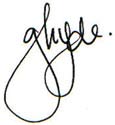
– Gillian Hyde (IAM:typealice)
| Gillian Hyde (IAM:typealice) is a vagabond, though her roots run deep into Nova Scotian soil. She’s lived and worked on three continents since 2001, and has never lived anywhere for longer than eight months since the age of 16. She loves fonts, puns, being barefoot, and office supplies. Calm to her is the roar of the ocean.
Online presentation copyright © 2005 BMEzine.com LLC. Images of Inza’s scarification © Emilio Gonsalez. Requests to republish must be confirmed in writing. For bibliographical purposes this article was first published online May 30, 2005 by BMEzine.com LLC from La Paz, BCS, Mexico. |
 |
Overdone v2.0: Why do people get wing tattoos? [Guest Column – Stepping Back]
|
In late 2004, Shannon (IAM:glider) published an article on why people get star tattoos, allowing each person to explain why they made the decision to get stars. We know that there are a lot of other popular themed tattoos — butterflies, hearts, tribal designs, skulls, kanji, flowers, and cartoon characters are all widespread designs, peppered through different cultures, religions, and locations around the globe. I wanted to explore why people get wings (most often) on their backs. Are they the type of people who’ve always longed to fly? Do they do it for religious or spiritual reasons — designed after the wings of an angel? Do they love nature and want to have the colours and design of a butterfly? No one will disagree that wings are a popular subject for tattoos, even Nicole Richie has wings… not that she’s the final say on things that are popular… by any means. *** I spoke with the one of the first people to ever get full-back angel wings — if not the first — Elayne Angel, who got them in 1986 by Bob Roberts. She is renowned as one of the pioneers of professional body piercing in the United States and she founded Rings of Desire Inc. Body Piercing, in New Orleans, Louisiana in 1993. Angel served two terms on the Board of the Association of Professional Piercers (APP) and her wings are the first and only tattoo that’s ever held a registration from the U.S. Patent and Trademark office.
Elayne Angel’s Service Marked tattoo, and one of the first full-back wing tattoos in existence.
*** So why get wings? Are people worried about any uniqueness being lost because of the popularity of wings? I spoke to several different people who allowed me to explore their tattoos with the hopes of teaching others that each person and tattoo is still unique, regardless of their popularity.
Each one of these people has a different motivation for getting their wings, so if you see them, or anyone bearing this type of tattoo, don’t automatically regard them as trendy; they chose that design because it’s a symbol for an important belief or event in their lives, and wings are a beautiful way to express these things. If you don’t like their tattoo, look past the it and into the reason behind getting it. If you’re considering getting your own set of wings, I ask one thing of you: make your design unique. No one likes to spend time, energy and money working on a one-of-a-kind tattoo for it to be ultimately copied and lose that quality. Imitation is not a form of flattery when it comes to tattoos — it’s an insult.
– Gillian Hyde (IAM:typealice) |
|||||||||||||||||||||||||||||||||||||||||
|
|||||||||||||||||||||||||||||||||||||||||
Quilt of Life [Guest Column – Stepping Back]

Quilt of Life
Modifications allow some people to reclaim their bodies. Tired of letting other people take advantage of them, whether through sexual or physical abuse, the victims can take charge and alter and use their bodies in a way that they decide. Such is the case for Amy S. (IAM:piercednpainted) who, after years of hardships, is finally seeing who she really is — with help from her piercings and tattoos.
Amy grew up in the small town of Bloomington, Illinois. Her abuse started at age eleven, in 1971, and continued until she was twenty-five. In 1972, she was kidnapped and raped for 24 hours by someone she didn’t know. After escaping, she ran away to the Los Angeles area and was kidnapped again and held hostage for four months by a BDSM group. At about age thirteen, her mother put her in a mental ward because she was disobedient, and she was, again, molested — this time by other patients. For fourteen years, there were uncountable rapes and abusive situations carried out by family members, friends and strangers. She was married to an alcoholic at age sixteen, and was a mother before her eighteenth birthday. The abuse is something that’s extremely difficult for Amy to talk about, but is something that has shaped her into the person she is today. At first glance, you may not think that Amy is heavily modified. She works in an office where she wears collared shirts and long skirts. She removes her septum and labret piercing every day before going to work out of respect for her employers. She’s forty-four years old, now happily married, and is a mother of two and a grandmother of one. She lives a simple life with her husband, cats, and dogs. 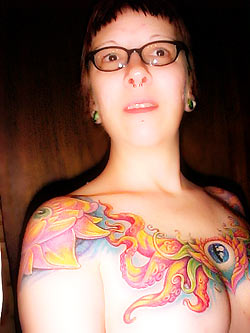 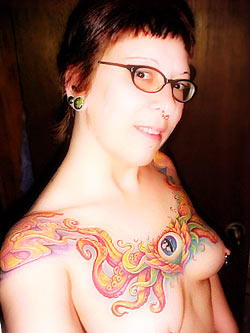 Her skin tells a different story though. Under her clothing lays design after design, brightly coloured in different styles, every tattoo telling a unique story or life lesson, each having a different meaning. She’s named it her “Quilt of Life,” and she’s been modifying her body for more than 25 years, and with each piece, she says she feels more like “herself.”
Tattoos and piercings obviously give different people different things, whether it’s simply for aesthetic reasons, fitting in or standing out, and in this case, healing. I can’t think of a better reason to get modified. Amy is an extremely strong woman who gains her strength from a pretty unconventional method. It’s a tried and true way for Amy to deal with her negative emotions; it’s a way for her to never forget the events that have shaped her into who she is today. Her past is now etched into her body with colourful symbols, and what’s most important about it is that she feels like herself. She’s the one who’s in complete control of her body and her life — and she’s doing something to her physical self that no one can ever take away from her. “I look at myself and I still see bare spots. I don’t feel heavily modified, I just feel like I’m me.”
– Gillian Hyde (IAM:typealice) |
|||||||||||||||||||||||||||||||||||||||||||||||||||||||||||||||||||||||||||||||||||||||||||||||||||||||
|
|||||||||||||||||||||||||||||||||||||||||||||||||||||||||||||||||||||||||||||||||||||||||||||||||||||||
Kivaka: Bedside Manner like a Nun [Guest Column – Stepping Back]

Kivaka
You can tell when someone loves their job. You can feel their passion and their excitement, and because of that, you know that they’re going to do the best job that they can. Loving your job makes you want to perfect your tasks, you care about every detail, and you want to learn everything you can about it. IAM:Kivaka loves what he does, and it shows. I’ve read a lot of experiences on BME, and I have to say that there are very few piercers that compare with Kivaka on the amount of positive feedback contained within those experiences. People literally rave about him. Now, I’m not saying that other piercers aren’t as qualified to pierce, or don’t love it as much as Kivaka does, all I’m saying is that his passion for piercing is evident to anyone that comes into contact with him. Just look at these testimonials:
David Klaus Pavin Jr. is known as Kivaka (pronounced key-vee-ka) to everyone except his mother and a few close friends. He’s been exposed to tattooing since he was a young boy and got his first tattoo at age ten by a friend of his, in what he describes as a “jailhouse method” with soot and pushpins. He’s been piercing for nearly fifteen years and is extremely passionate about it. In 2004, he was ranked the third highest person on BME for photo submissions, and while he’s unsure of how many he does in comparison to other piercers, he does a lot of genital piercings. Kivaka and his friend and business partner Tim (IAM:inkdrtim) are opening a new tattoo and piercing studio in Joliet, Illinois. Tim met Kivaka while he was tattooing at Lake Geneva Tattoo, in Wisconsin. When he decided to open a shop of his own, he asked Kivaka to join him in his endeavor, knowing that he’s a hard worker and that he has “a bedside manner like a nun.” Building it nearly from the ground up, Advanced Studios will have their grand opening on June 1, 2005. The shop will offer quality tattoos and piercings with fair and honest prices, a great atmosphere and love. Kivaka fully admits to putting his heart into his work and says that the difference between a good piercer and a bad piercer depends on two things: “First, The piercer should love what they do and not do it to be cool, and second, they care about the person and not the money.”
I had the privilege of interviewing Kivaka on the phone for nearly an hour, where we talked about his career, the steps he’s taken to make piercings safe for people in the state of Wisconsin, and the ups and downs of being a piercer. ***
With passion as evident as Kivaka’s, he’ll be sure to have a long, happy career. I wish he and Tim the best of luck with the opening of their new shop. In addition to his pictures on BME, see more of Kivaka’s work at Kivaka.com — Gillian Hyde (IAM:typealice) |
||||||||||||||||||||||||||||||||||||||||||||||||||||||||||||||||||||||||||||||||||||||||||||||||||||||||||||||||
|
||||||||||||||||||||||||||||||||||||||||||||||||||||||||||||||||||||||||||||||||||||||||||||||||||||||||||||||||
Marked for Life [Guest Column – Stepping Back]

|
||||||||||||
| BME: | You three were tattooed in prison — and you all knew the health risks of getting a tattoo. I know that getting tattooed in prison isn’t just about the artwork — but more for the culture. How long were you in prison before deciding to get a tattoo, and why did you get it done? |
| CAM: | I waited about three months to get one done. They are in high demand, and I was low on the totem pole to get one. It was prison rules not to get one, as it was considered self mutilation, and it could get you in the hole for a week, and even longer for the artist. It can take time for the artist and their posse to trust you. Trust is earned in jail so I earned it and kept it. I got mine out of respect for some of the guys that watched my back: it proved my loyalty to them. |
| JAREB: | It wasn’t until my fourth bid, and I got it for safety. |
BEAR: |
I got mine because I wanted something permanent to remind myself of where my idiocy had delivered me. I waited until my third sentence, in the fourth year though. |
| BME: | Inmates don’t usually carry around cash, so there are different kinds of currency in prisons. Just from watching movies, I know you can barter cigarettes, drugs, and sex. In your experience, what did you see traded for a tattoo? |
| CAM: | A lot of times it would be cigarettes, drugs or favors, like running errands for them or just keeping your alliance and showing your respect. |
| JAREB: | Price was never much of an issue. You traded whatever you had. A lot of artists were just bored and needed something to do. |
| BME: | I picture tattoo artists in jail being held in high regard and viewed with great awe and admiration, sort of the “leader of the pack.” Is there any truth to that? |
| JAREB: | Generally you’re right — we were treated with more respect than anyone else. |
| BEAR: | They were looked at very highly, but only if they did good work. They weren’t looked at so well if they fucked someone up. |
| BME: | What were their tattoo machines like? What were they made with, and how did those supplies get into the prison? |
| CAM: | Proper tattoo ink was brought in either by guards, visitors, or inmates who had work furloughs. The machines on the other hand, were makeshift from blow dryer parts — usually for the motor, and a regular needle in conjunction with empty plastic casing from a Bic pen. |
| JAREB: | The machines were really shady — usually made from ballpoint pens and motors from cassette players. The “needles” were straightened paperclips or guitar strings. “Ink” was made from burning plastic chess pieces and collecting the ash soot. Pens and everything else were from the commissary. |
| BILL: | Some machines were made with various items, like pens with motorized parts taken from fans, radios, and other devices, but many used the “pluck” method of using ink with a single needle. |
| BEAR: | My cellmate had a professional unit. It had been smuggled in and he had kind of inherited it from a guy who got out. In my case, the supplies were smuggled in, but I have seen pen ink used.
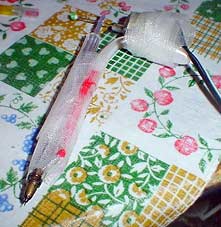 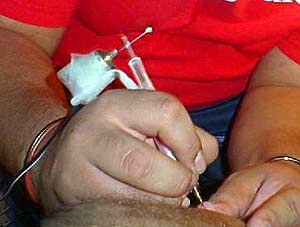 Improvised tattoo machine; electric motor, pen, and guitar wire.
|
| BME: | None of those supplies seem that sterile, especially if they’re used over and over on different people — so I’m wondering — what steps were taken to keep things clean, if any? Where were the tattoos done? |
| CAM: | For me, there was nothing done to sterilize anything. I bled very badly and they used a very dirty needle on me. Tattoos were done in the artist’s cell, and always with a few people keeping watch, as not to get caught in the act. |
| BILL: | People would boil the equipment in water, and the tattoos would usually be done in the tattoo artist’s cell. |
|
BEAR: |
I worked in the kitchen, so I had access to a pressurized steam kettle which had to be cleaned daily using bleach water. I would take the needles to work with me and then while cleaning the kettle, I would just put the needles in. Then I would wrap them in napkins and sneak them back to our cell. Tattoos were either in the bathroom (I know, it’s scary), or our cell. |
| BME: | With these very basic supplies, tattoos would be fairly simple designs, right? I mean, how intricate can a tattoo be that’s been done with a guitar string and ink from a pen? What were some common tattoos done in jail? |
| CAM: | There was a lot of racial or affiliation tattoos or tough stuff like tear drops and other masculine items. My tattoo was pretty unusual as it’s not too “manly.”
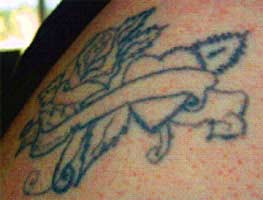 Cam’s tattoo, complete with a heart and rose.
|
| JAREB: | Because of the supplies available, only black and grey work was done, so there were a lot of skulls, gang symbols, names, and spider webs on the elbows. |
| BILL: | It was the same in my case: I saw a lot of chains, names, teardrops, images of clocks, spider webs and gang symbols. |
| BEAR: | Actually for some reason, names were popular; you would think that cons would know better. Once in a while, there was some really nice fantasy work done. |
| BME: | All of those themes are very similar, more than I thought there would be — especially because all of you went to different jails in different states and provinces, but what do they all mean? |
| BILL: | There’s always your common “done time” pieces, like I said: chains, locks, clocks, hourglasses, and so on. Spider webs on the elbow used to signify that you took a life, but it’s now become fashionable and doesn’t necessarily mean that anymore. Teardrops either mean that you took a life, or lost someone close to you.
Most gangs have there own specific symbols, which can also vary from which branch, hood, or part of the country or world they’re from. Bloods commonly use wolf prints, wolf heads, and other lupine symbols, as well as pentagrams. Crips use the Star of David, as well as a crescent moon, which is also commonly used by Five Percenters. The Latin Kings have a three pointed crown, and Aryans and Bikers use Nazi symbols. Then there’s the obvious symbols used by different Anglo groups, like Shamrocks for the Irish, and national flags for whatever the person’s background is. Memorials, portraits, and banners of loved ones are also very common. |
| BME: | So, let’s say that someone goes into jail who’s previously tattooed — all high quality work, and then they get tattooed in jail, and it turns out pretty badly. Are they given a lot of flack from other inmates about their standards? |
| BEAR: | That they are. If you have good work, and then get some crap, then people give you shit about it. Most people who have tattoos going in are kind of snobbish about jailhouse work. |
| BME: | Bear, you’ve been in several different jails — did you see much diversity in the tattoo culture between those jails? |
| BEAR: | In my incarcerations, I did not see a big change from prison to prison unless you are talking about gang related work. With the gang tattoos, if the gang represented was not strong in a particular prison, then the tattoos were downplayed and not on display as much, for obvious reasons. The one other change that I experienced was that as you worked your way down from maximum to medium and then onto minimum security, the quality of the work seemed to go down. I credit this to the fact that when you’re in maximum and someone messes you up in a permanent way, you have less to lose, and are more willing to seek revenge with physical retribution. |
| BME: | There are lots of people who come out of jail with swastikas and gang symbols that they eventually regret. They may regret them because the symbols don’t have any meaning outside of jail, because it reminds them of a bad time in their life, because they have changed so much and can’t relate to the person they were inside of jail, or just because the tattoo is of such poor quality. Do you regret getting your tattoo? |
| CAM: | No, not at all. |
BEAR: |
No, I do not. In fact, I am going to have it redone as it has faded somewhat. |
| BME: | Some men go into jail and come out without getting a tattoo, and there are other men who come out with lots of tattoos. If you were in jail for any longer, would you have gotten more? |
| CAM: | No. I got mine and that was enough. Again, I got it to show my respect to the people who watched my back — I can’t express how much the culture in jail revolves around trust and your word. It’s really all you’ve got. I got one outside of jail as well, but the experience was nothing like it was in jail, not only the procedure, but there were no politics involved with that one. |
| JAREB: | Yes, I would have. |
| BEAR: | Probably not, as I had already begun to collect cartoon characters and I did not want to ruin the theme. Besides, even with what we were doing for sterilization, it was dangerous. |
 A tattoo born in prison. |
|
| BME: | Did your tattoo provide any safety against violence? |
| JAREB: | Yes and no. It showed the crew that I rolled with, and that comes with both safety and danger — it all depends on the politics of the gangs at the time. |
| BEAR: | No, it did not. Being six feet tall and 275 pounds did, I guess. And the old saying holds true: “Convicts do time, an inmate’s time does them.” If you don’t fuck with people, people don’t fuck with you. Usually. |
| BME: | Guards have enough to worry about — with violence and keeping everyone in check. Was it a priority for them to try to stop inmates from getting tattooed? |
| CAM: | It depended on the guard. If we were caught, we’d get time in the hole, and then time in the infirmary to have the damaged tissue removed. |
| JAREB: | The guards generally did nothing. Once in a while there’d be a raid and machines would be taken, but new ones would be made that same day. |
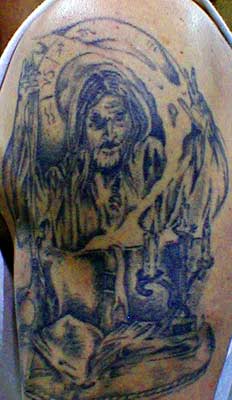 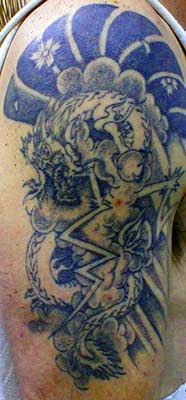 These tattoos were created by a single-needle machine in a prison in Michigan. |
|
| BME: | So, it’s been a while since you’ve gotten out of prison, but you still have your tattoo there to remind you of that time in your life. Bear, what do you think of your tattoo now (especially because your personality has changed so much)? |
| BEAR: | I used to be a very sick, racist asshole who was completely intolerant of anything or anyone different. It doesn’t make much sense because I am different than other people. One day, I just realized that fact and everything changed. While my tattoos remind me of a really crappy time in my life, they do show me where I was then and how much I’ve changed, and I like them for that. |
| BME: | As you may have heard, Canada is planning on implementing a “tattoo service,” which allows inmates to receive cheap and sterile tattoos. What do you think of this program? Do you think more inmates will get tattoos because of it? Have you known anyone to get hepatitis C or other illness from getting a tattoo? |
| CAM: | Cheap and sanitary tattoos are a good idea, but it may take away from that culture in jail. Earning a tattoo or being branded is important to inmates. Maybe they should start a program and let the inmates govern it, as the more they take from them, the worse things can get. I don’t know anyone who has gotten sick from it, but I’m sure it happens a lot — most probably wouldn’t discuss it. |
| JAREB: | I think more programs like this need to be implemented. Tattooing is never going to stop, and the health risks are too great. Maybe more inmates will get tattooed, maybe not, you can never really tell. I have known a lot of people to get really sick, and yes, get hep. It’s not nice to witness people getting sick from diseases that are not being treated because of where they are.
I think it is hard for people who have never been in jail to make rules for what should happen in jail. How can you tell someone to live a certain way if you yourself are never going to have to live it? |
| BEAR: | I think it is a very good idea. Prison should be about rehabilitation, not retribution. Part of being rehabilitated is improving your self image, and tattoos do that. I do think that more inmates will get tattoos, which is a shame since most will probably do it for the wrong reasons, and they won’t think it through. Plus, I would imagine that the administration will not allow gang tats, so those will remain underground. And while I’ve heard a few horror stories, I do not know anyone personally who has gotten anything from a tattoo. |
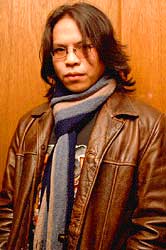
|
|
| BME: | How many people have you worked on who’ve been in jail and are looking for cover-up tattoos? |
| JOHANN: | I can’t recount the many times I have seen and worked on tattoos that originated in jail. I have probably documented at least about thirty or so over the years which were worth photographing. I know for a fact I have done many more than that, I just never took a picture of them (probably because it wasn’t that much of a noteworthy tattoo that they wanted me to cover their tattoo with, or they wanted me to rework the jailhouse line work and I had very little input on the tattoo). |
| BME: | We’ve heard from these men in this interview that gang related tattoos and other prison-themed work is common. What kinds of tattoos have you seen that people are interested in getting covered up? |
| JOHANN: | It differs from individual to individual, but most people usually cover up old gang insignia, racist imagery, vulgar or offensive lettering, or just plain ugly tattoos. Sometimes, they want me to rework some of their tattoos that they received on the “inside” and sometimes it’s possible to make it totally new and “cleaned” up. Sometimes the work is so badly scarred or blown out that I would liken the process to “polishing a turd.” |
| BME: | What should people know who are looking for cover-up work? It must a difficult task sometimes because of the colour of the initial ink and poor quality of the tattoo. |
| JOHANN: | The general rule of thumb concerning cover-up work is that usually only darker colors mask dark colors; meaning that you can’t put yellow over black line work and expect it to “erase” the black and make it appear yellow. There are factors involved as well, like how old the tattoo that is that’s going to be covered up, for example. You’d have a better chance of success blasting some yellow over some old black line work that has had twenty years to fade, as opposed to black line work from two years ago. Of course, yellow over a grayish faded black ends up being a muddied mix when layered on top of each other, but with the right skill and technique, it can totally be applied in a tattoo correctly without looking like a mistake.
So, with that in mind, darker imagery usually works best: panthers and eagles, and black tribal have been tried and true examples, although a lot of really talented folk out there can do a cover-up with much more lighter colors in the piece. A perfect example would be cover-ups by either THE GRIME or Guy Aitchison. Not to single those two out, as there are tons of talented artists out there, but those two stick out in my mind as masters of their craft and really do well in the cover up department. |
| BME: | Have you spoken to your customers about the specific reason behind wanting to cover up their tattoos? |
| JOHANN: | Some do it to rid themselves of a bad tattoo. They probably realized the difference in quality between different artists, as opposed to just having one choice of artist in jail. Others choose to cover it up so that they wont have to be haunted by reminders of their past. |
| BME: | Do they seem embarrassed about the work that they’ve gotten in jail? |
| JOHANN: | It’s a mixed bag. Some are regretful, and proceed to get a cover-up or get it lasered off, while others get tattooed around the jailhouse piece to remind themselves of their time inside. |
  Before and after shots: cover-up work by Johann. |
|
| BME: | Has anyone mentioned what kind of feedback they’ve gotten from people in the “real world”? |
| JOHANN: | One particular guy I tattooed, I covered a jailhouse swastika on his leg. Once he got out of jail, he went the straight and narrow and successfully found a job and had a family. Years later, other parents saw his swastika on his leg when he took his daughter to school while he was dressed shorts. Whether or not the swastika symbolized anything negative or positive, he felt that he didn’t want to jeopardize his daughter’s upbringing by other’s cultural views placed on him. |
| BME: | Did they mention why they got the ink they got (like for protection and so on)? |
| JOHANN: | Some said it was to pass the time, others said to show allegiance to their gang, whilst others found spirituality and wanted to show their devotion. For whatever reasons, there is some “intimidation” psychologically when one sees a tattooed inmate. It has been said that old sailors used to tattoo the face of Jesus on their backs to save themselves from lashings. Perhaps this mentality is still shared today? |
| BME: | What is the general quality of the tattoos you’ve seen born in prison? |
| JOHANN: | Where there is a will, there is a way. I never doubt the power of desire. A lot of talented people exist in all walks of life, including those who are incarcerated. Inasmuch as there are a lot of bad tattoos done in jail, there are also a few artists who are exceptional and do amazing work.
Given the limitations (tattoos are usually illegal to do inside prisons and materials are scarce) and lack of color, I have seen beautiful work done with just a makeshift rotary machine and a single needle. I have to respect that determination. |
  More cover-up work by Johann. |
|
In addition to the health risks, there is the risk of social stigma after release from prison with the popularity of gang symbols and extremist racial views. While behind bars these are overall accepted and respected, once the person completes their sentence, they’ve got something on their bodies that they may not be so proud of any more. They’re “stuck” with a marking on their body that can really only remind them (and the people who see it) of one thing — doing time — and if they’re not proud of that, then there’s an expensive problem. Laser treatment is an option, but people can expect to pay hundreds of dollars per visit, and most need between six and twelve treatments. That’s a lot of money.
Lucky for people like Johann, there’s been a consistent flow of people coming into his studio looking for cover-up work. As far as hiding the work you’ve gotten done in prison, it’s probably the most economical method: a palm sized tattoo by Johann would cost about $150.00.
Overall I agree with the CSC program — I’m a strong believer in avoiding problems rather than attempting to fix them once they happen. Tattooing in jails is unavoidable and I don’t think a lot of the men in prisons necessarily care about the consequences of their actions — I mean, if they did, they likely wouldn’t be in jail in the first place, right? We, the people on the outside, may as well make it as safe for them as we can, if not for their sakes, for ours.
– Gillian Hyde (IAM:typealice)
Gillian Hyde (IAM:typealice) is a vagabond, though her roots run deep into Nova Scotian soil. She’s lived and worked on three continents since 2001, and has never lived anywhere for longer than eight months since the age of 16. She loves fonts, puns, being barefoot, and office supplies. Calm to her is the roar of the ocean. Online presentation copyright © 2005 BMEzine.com LLC. All cover-up images are © Johann Florendo.Images of tattooed arms are © Patrick Warnement. All other tattoo images are from the BME archives. Requests to republish must be confirmed in writing. For bibliographical purposes this article was first published online April 16, 2005 by BMEzine.com LLC from La Paz, BCS, Mexico.




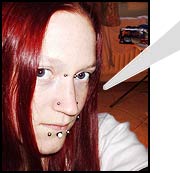
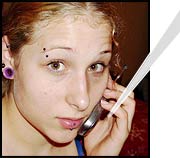
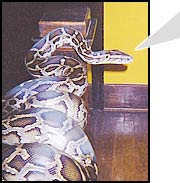


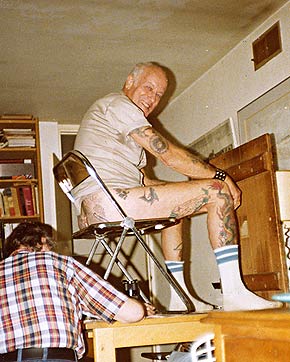
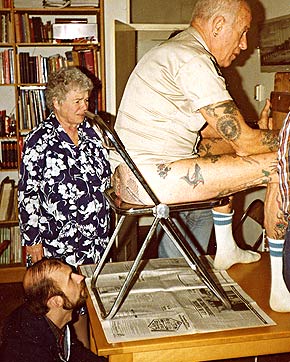

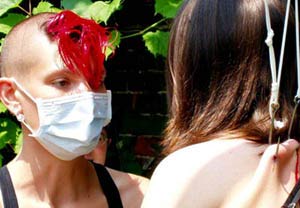
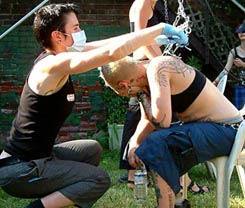

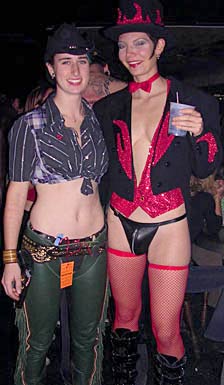
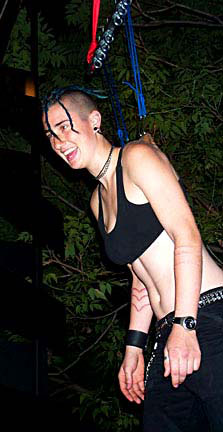
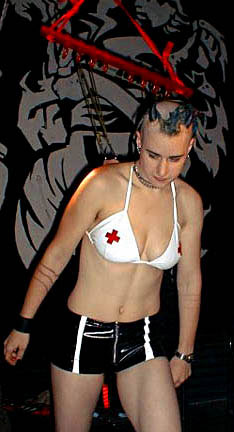
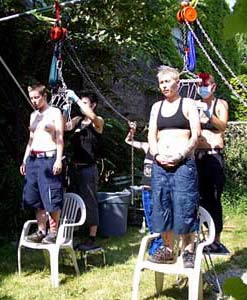
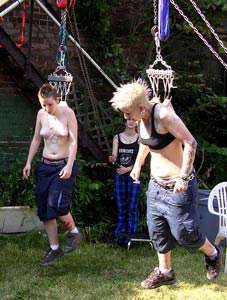
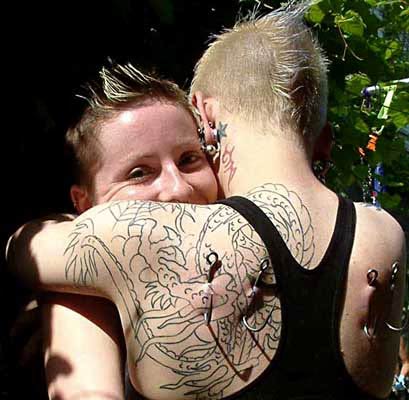
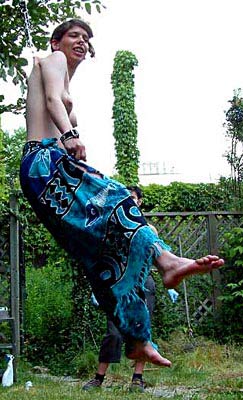

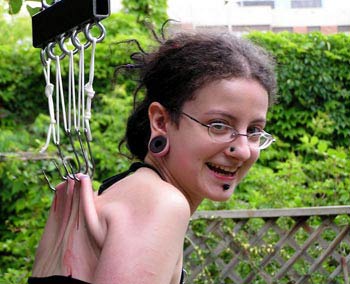
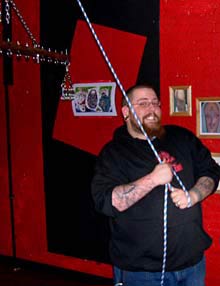
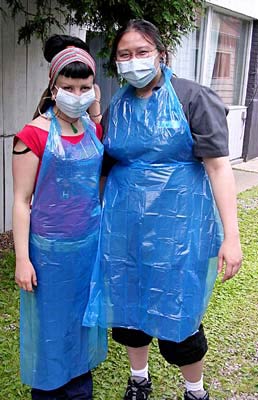

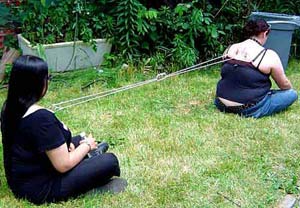
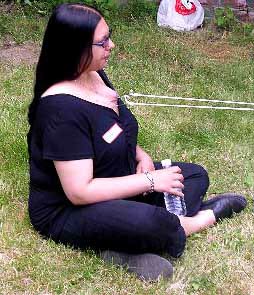
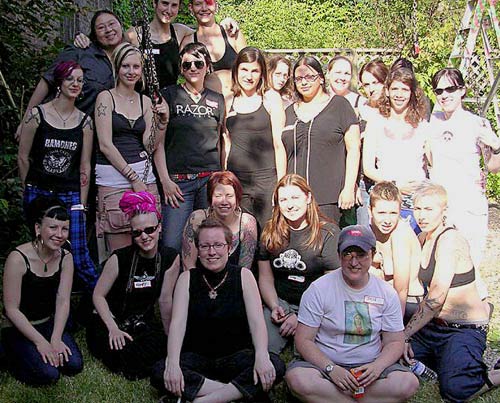
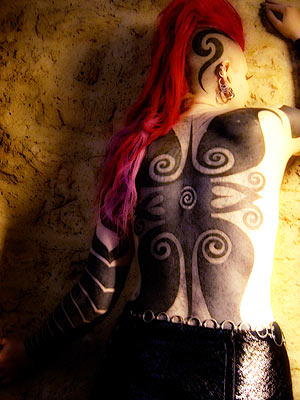
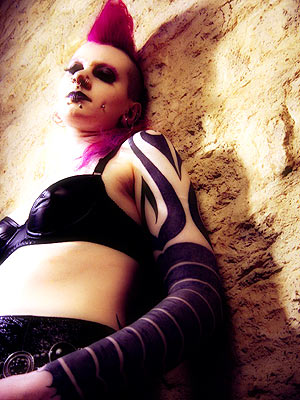
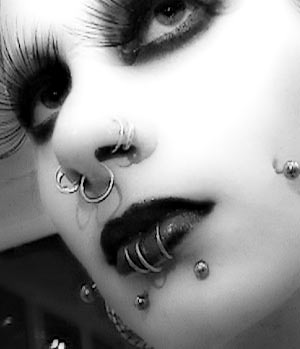
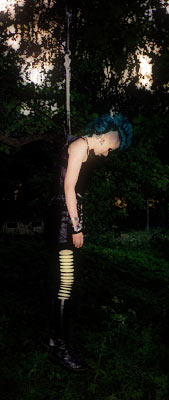
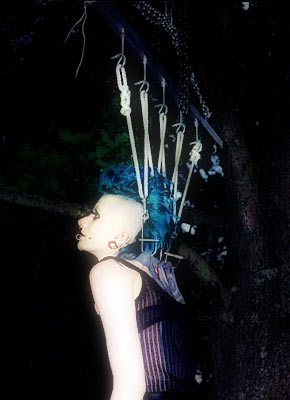


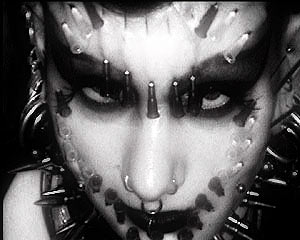

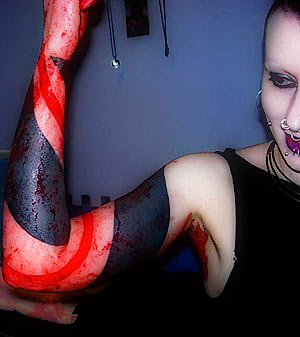
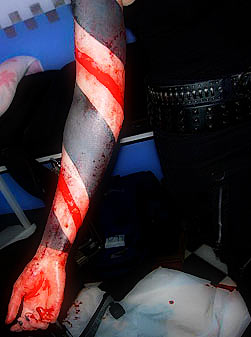
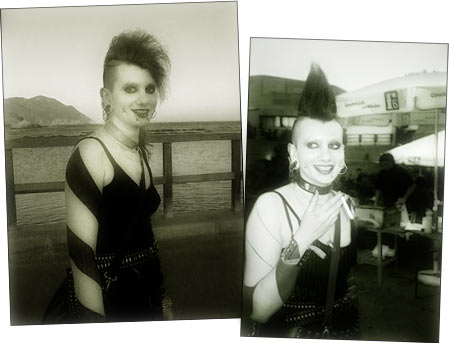
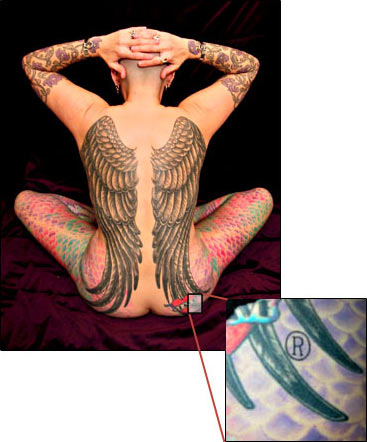
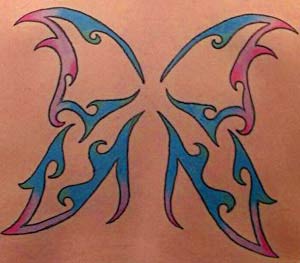 Kathryn is a 21 year old welder from Melbourne, Australia. She plays the cello and has been getting modified for the past four years.
Kathryn is a 21 year old welder from Melbourne, Australia. She plays the cello and has been getting modified for the past four years.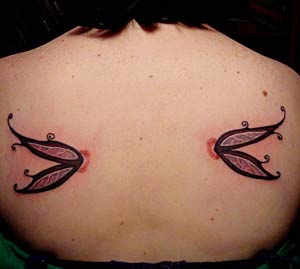 Désirée Fawn Kretschmar (IAM:
Désirée Fawn Kretschmar (IAM: Mike Johnson is a 45 year old self-described Aries/Rat who lives in Charlottesville, Virginia. By day he does layout and design work for a local newspaper, picking up freelance work when he can, from business cards to CD designs for local bands. By night he’s a drummer who plays in alternative, hard rock, punk, or gothic groups, depending on where his head is at the time.
Mike Johnson is a 45 year old self-described Aries/Rat who lives in Charlottesville, Virginia. By day he does layout and design work for a local newspaper, picking up freelance work when he can, from business cards to CD designs for local bands. By night he’s a drummer who plays in alternative, hard rock, punk, or gothic groups, depending on where his head is at the time. Nicole is a preschool teacher from Orlando, Florida who’s been modified for the past five years. She says that road rage is her worst habit, and she strongly dislikes it when people watch her being tattooed.
Nicole is a preschool teacher from Orlando, Florida who’s been modified for the past five years. She says that road rage is her worst habit, and she strongly dislikes it when people watch her being tattooed.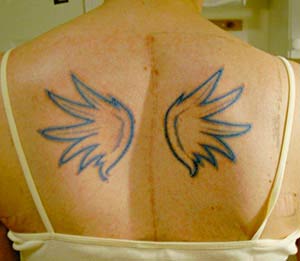 Jenn (IAM:
Jenn (IAM: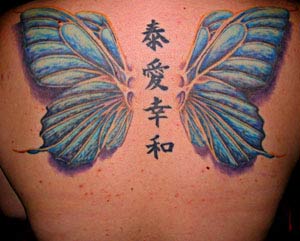 Marisa Terres is from Lompoc, California and is a 21 year old student. She’s interested in contortionism and wants to be able to sit on her own head someday.
Marisa Terres is from Lompoc, California and is a 21 year old student. She’s interested in contortionism and wants to be able to sit on her own head someday.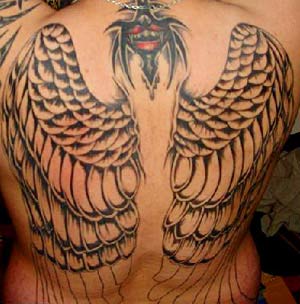 Pops (IAM:
Pops (IAM: Emily (IAM:
Emily (IAM: Sandra O’Conner (IAM:
Sandra O’Conner (IAM:
